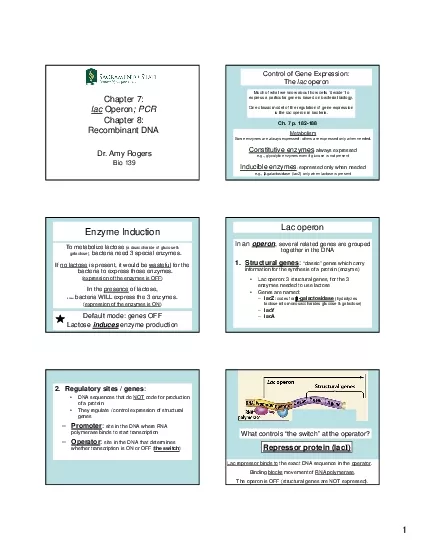

Some enzymes are alwaysexpressed others are expressed only when neededConstitutive enzymesalways expressedeg glycolyticenzymes even if glucose is not presentIn the presencesomebacteria WILL express th ID: 858996
Download Pdf The PPT/PDF document "Metabolism" is the property of its rightful owner. Permission is granted to download and print the materials on this web site for personal, non-commercial use only, and to display it on your personal computer provided you do not modify the materials and that you retain all copyright notices contained in the materials. By downloading content from our website, you accept the terms of this agreement.
1 Metabolism Some enzymes are alwaysexpres
Metabolism Some enzymes are alwaysexpressed; others are expressed only when needed.Constitutive enzymes always expressede.g., glycolyticenzymes even if glucose is not present In the presence somebacteria WILL express the 3 enzymes. (expression of the enzymes is ON Default mode: genes OFFinduces enzyme production (hydrolyzes lactose into monosaccharidesglucose & galactose)lacYlacA 2.Regulatory sites / genesDNA sequences that do NOT code for production of a protein site in the DNA where RNA polymerase binds to start transcription site in the DNA that determines whether transcription is ON or OFF (the switch ) 2 Lac repressor protein Lac igene (for repressor protein)Constitutively expressed (always ON)lacis NOT physically part of the operon, but is located somewhere else in the chromosome How to flip the switch? Lactose, when present, will bind to the repressor proteinShape of lacrepressor is changed by lactose bindingRepressor bound to lactose CANNOT bind to the operator sequence In p
2 resence of lactose Operonis de-represse
resence of lactose Operonis de-repressed.Structural genes needed for lactose metabolism (lacZ, lacY, lacA) are expressed (turned on) What would happen if Mutation in operator sequence?Mutation in lacZgene?Mutation in promoter sequence?Mutation in lac Repressor could not bind; structural genes expressed constitutively Expression still inducible by lactose, but -galactosidasemight not work 1.If repressor could no longer bind the operator, then constitutive expression of the structural genes (switch always ON)2.If repressor could no longer bind lactose, then impossible to de-repress, operator always bound by repressor (switch always OFF) RNA polymerase could not bind; structural genes nevertranscribed; bacteria could not use lactose Depends on the mutation . ch. 8 p. 221-224 one species to anotherGenetic code is virtually the same in all life Gene for a (human) protein can be expressed in bacteria MANY applications; classic example:Using genetically engineered Insulin is a human hormone de
3 ficient in type I diabetics.Prior to 198
ficient in type I diabetics.Prior to 1982, these patients injected insulin purified from slaughtered pigs.Problems Patients develop allergies to non-human (pig) insulin; contamination; cost 3 How to make recombinant bacteria 1.Cut human insulin gene from human 2.Cut open a Self-replicating gene carrier , often a plasmid 3.Paste human insulin gene into vector4.Insert vector + insulin gene into bacteria5.Select for recombinant bacteria by growing on antibiotic How to cut DNA Restriction endonucleases also called restriction enzymes, enzyme that cuts DNA backbone, cuts at internal sites, not just at the Key features:Sequence specific Sticky ends Restriction endonucleases Sequence specific Each restriction enzyme will cleave DNA at a specific recognition sequence, usually 4 to 6 nucleotides long.EcoRI(famous restriction enzyme)Recognition sequence: GAATTCCTTAAG Restriction endonucleases Sticky ends The enzyme cuts each DNA strand in a different place. Separation of the two strands then lea
4 ves single-strand overhangs, called stic
ves single-strand overhangs, called sticky ends.Stickybecause the single strand overhangs want to hydrogen bond/base pair with anothercomplementary single stranded DNAEcoRI: G A A T T CGAATTCC T T A A GCTTAAG = cut site Sticky ends How to make recombinant bacteria(or, how to clone a gene) Insulin gene Human Restriction enzyme recognition sites Step 1. Cut human insulin gene from human chromosome Sticky endsInsulin gene Steps 2 & 3. Cut open a vector; paste insulin gene into vector Insertion of humaninsulin gene(with compatible sticky ends) insulin gene ligated(pasted) in 4 Step 4. Insert recombinant plasmid into bacteria (transformation) How to make recombinant bacteria 1.Cut human insulin gene from human chromosome Use a restriction enzyme that cuts on both sides of the gene2.Cut open a vector Use the same restriction enzyme to make compatible sticky ends3.Paste human insulin gene into vector Ligase closes the breaks in the DNA backbone4.Insert recombinant plasmid into bacteria Use tr
5 ansformation to get the plasmid inside5.
ansformation to get the plasmid inside5.Select for recombinant bacteria by growing on antibiotic Only bacteria carrying the recombinant plasmid are resistant; wildtypebacteria die Once you have a pure culture of the recombinant bacteria, they will express the foreign gene and insulin!Most insulin-dependent diabetics in the U.S. use human insulin manufactured by recombinant bacteria Thats just the beginning Human growth hormoneErythropoietin (epo)Hepatitis A & B vaccinestoxin (insecticide) in agricultureVitamin production in food cropsGenetic engineering of mammals to produce desired proteins milk Polymerase Chain Reaction (PCR Large-scale amplification of tiny A few uses:Medical diagnosticsTest for infectious disease, genetic abnormalitiesForensicsRape, murder casesStudy of DNAsfrom long agoJurassic Park, evolutionary studies Principle of PCR Start with one DNA molecule; replicate itRepeat, repeat, repeat = exponentialincrease in the # of DNA copiesReplication occurs in cycl